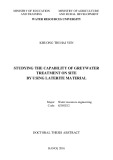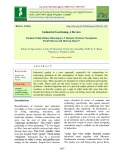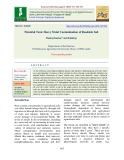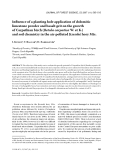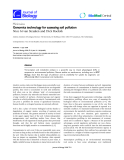
Soil pollution
-
The primary objective of this study is to elucidate the chemical speciation of copper (Cu) and conduct an assessment of the magnitude and probability of contamination of Cu in soil samples procured from the Pb/Zn mining, at the Hich village, Dong Hy district, Thai Nguyen province, in order to furnish critical data pertinent to the environmental stewardship of soil resources within this geographical domain.
 10p
10p  viengfa
viengfa
 28-10-2024
28-10-2024
 3
3
 1
1
 Download
Download
-
Phosphorus (P) is essential for plant growth, but most of it in soil is insoluble and unavailable to plants. To increase crop yields, farmers use chemical fertilizers, causing soil pollution from the accumulation of insoluble P. Beneficial microorganisms called phosphorus-solubilizing microorganisms (PSMs) can change insoluble organic and inorganic phosphorus compounds into forms that plants can absorb. This article seeks to deepen knowledge of how PSM can improve plant growth, decrease soil phosphorus contamination, and contribute to the future of sustainable agriculture.
 11p
11p  viaburame
viaburame
 14-03-2025
14-03-2025
 5
5
 1
1
 Download
Download
-
The aim of research: Determination of greywater characteristics from some buildings in Hanoi city; Explaination of the principle of removing the main pollutants out of greywater by using laterite with multi soil layering engineering; Determination of decomposition rate coefficients of BOD5, COD and NH4 + -N. The number of laterite layer is calculated based on these coefficients; Successful greywater treatment from building by using laterite with Multi Soil Layering engineering and the treated effluent meet up the National Regulations
 27p
27p  dolphintaletale
dolphintaletale
 23-04-2021
23-04-2021
 25
25
 9
9
 Download
Download
-
Industrial garden is a new approach, especially for competition in increasing pollution in the atmosphere. It helps easily to beautify the industrial areas. The lawn laid in vacant lands not only adds beauty but also cut down dust. These gardens are designed to reduce pollution and beautify the world. These units are the most sources of air, water, noise and soil pollution.
 7p
7p  chauchaungayxua11
chauchaungayxua11
 23-03-2021
23-03-2021
 6
6
 2
2
 Download
Download
-
Assessment of trace metal contamination of soil in a landfill vicinity: A southern Africa case study
This study quantified pollution of soils by trace elements at the Roundhill landfill, South Africa using indices and multivariate statistics. Soils were collected and assayed for trace metals using x-ray fluorescence.
 12p
12p  tocectocec
tocectocec
 25-05-2020
25-05-2020
 20
20
 1
1
 Download
Download
-
As the urban area has high population density and intensive anthropogenic activities, there are a great number of sources of heavy metals in cities, placing a considerable influence on human health. Emissions of heavy metals may come from domestic waste, chemical industry and transportation. These emissions have been continuously adding heavy metals to soils and they will remain present for many years even after the pollution sources have been removed.
 7p
7p  nguaconbaynhay5
nguaconbaynhay5
 16-05-2020
16-05-2020
 24
24
 0
0
 Download
Download
-
Tham khảo luận văn - đề án 'báo cáo lâm nghiệp: " influence of a planting hole application of dolomitic limestone powder and basalt grit on the growth of carpathian birch (betula carpatica w. et k.) and soil chemistry in the air-polluted jizerské hory mts."', luận văn - báo cáo phục vụ nhu cầu học tập, nghiên cứu và làm việc hiệu quả
 11p
11p  toshiba4
toshiba4
 13-09-2011
13-09-2011
 79
79
 4
4
 Download
Download
-
Tuyển tập các báo cáo nghiên cứu về sinh học được đăng trên tạp chí sinh học Journal of Biology đề tài: Genomics technology for assessing soil pollution...
 5p
5p  toshiba3
toshiba3
 07-09-2011
07-09-2011
 54
54
 3
3
 Download
Download
-
The US Environment Protection Agency defines arsenic as a persistent, bio-accumulative, and toxic chemical having the ability to accumulate in the air, soil, and water. In 1961, the pollution of arsenic was first discovered in Taiwan, and later in Belgium, Netherland, Germany, Italy, Hungary, Portugal, The Philippines, Ghana, USA, Chile, Mexico, Argentina, and Thailand. In 1992, the toxicity of arsenic was found as a disaster in West Bengal, India.
 14p
14p  sinhtobo111
sinhtobo111
 25-04-2011
25-04-2011
 96
96
 11
11
 Download
Download
-
Pot and field trials were carried out using sediment dredged from the port of Bremen (Germany) and deposited in a settling basin near Bremen; the sediment is polluted with Cd and Zn. Five iron-bearing materials were added to the soil (1% pure Fe in soil dry matter) to immobilize the heavy metals: ‘Red mud from the aluminium industry, sludge from drinking-water treatment, bog iron ore, unused steel shot and steel shot waste.
 8p
8p  tudoia
tudoia
 06-04-2011
06-04-2011
 122
122
 7
7
 Download
Download
CHỦ ĐỀ BẠN MUỐN TÌM











